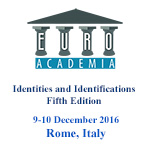Euroacademia Conferences
 Europe Inside-Out: Europe and Europeanness Exposed to Plural Observers (9th Edition) April 24 - 25, 2020
Europe Inside-Out: Europe and Europeanness Exposed to Plural Observers (9th Edition) April 24 - 25, 2020 Identities and Identifications: Politicized Uses of Collective Identities (9th Edition) June 12 - 13, 2020
Identities and Identifications: Politicized Uses of Collective Identities (9th Edition) June 12 - 13, 2020 8th Forum of Critical Studies: Asking Big Questions Again January 24 - 25, 2020
8th Forum of Critical Studies: Asking Big Questions Again January 24 - 25, 2020 Re-Inventing Eastern Europe (7th Edition) December 13 - 14, 2019
Re-Inventing Eastern Europe (7th Edition) December 13 - 14, 2019 The European Union and the Politicization of Europe (8th Edition) October 25 - 26, 2019
The European Union and the Politicization of Europe (8th Edition) October 25 - 26, 2019 Identities and Identifications: Politicized Uses of Collective Identities (8th Edition) June 28 - 29, 2019
Identities and Identifications: Politicized Uses of Collective Identities (8th Edition) June 28 - 29, 2019 The European Union and the Politicization of Europe (7th Edition) January 25 - 26, 2019
The European Union and the Politicization of Europe (7th Edition) January 25 - 26, 2019 7th Forum of Critical Studies: Asking Big Questions Again November 23 - 24, 2018
7th Forum of Critical Studies: Asking Big Questions Again November 23 - 24, 2018 Europe Inside-Out: Europe and Europeanness Exposed to Plural Observers (8th Edition) September 28 - 30, 2018
Europe Inside-Out: Europe and Europeanness Exposed to Plural Observers (8th Edition) September 28 - 30, 2018 Identities and Identifications: Politicized Uses of Collective Identities (7th Edition) June 14 - 15, 2018
Identities and Identifications: Politicized Uses of Collective Identities (7th Edition) June 14 - 15, 2018
Identification through Art (“Amikejo” Projects)
-
-

-
Presentation speakers
- Valentina Dal Fior, Atelier “Valeska Peschke”, Berlin, Germay
- Download presentation
Abstract:
The paper explores the complex issue of identification, intended as the open-ended and unfinished act of signification through which a community ‘imagines’ itself by transferring particular meanings to the surrounding reality, which finally becomes a space for cultural identity. In the formation of a social imaginary Art has undeniably a big role, the artistic object is in fact a direct vehicle of identity representation and reproduction, subject to an intrinsic form of ‘translation’. In explaining how art is translated into cultural symbols, the paper refers to Bhabha’s concept of hybridity, which denies the existence of a prior given original culture and introduces the notion of ‘Third Space’, the new third meaning emerging from two original moments in the act of cultural signification. Far from being finished and fixed, culture is always negotiated in a process of representation, signification and meaning making. After the theoretical framework, the case study ‘Place Internationale’, in Berlin-Hellersdorf, will show how monuments (in this case an inflatable column erected in the square centre) become vehicles and symbols of a local community identity. The column, inspired by both the Vendôme Column in Paris (destroyed during the Commune upon Courbet’s proposal) and the Trajan in Rome, will continuously modify its shape, first upright and straight and then falling down in a never-ending loop. Metaphor of an eternally hybrid identity, in the column one can see two distinct moments (standing and falling), synthetized in a third new space. Place Internationale square and the column have thus become narrating objects, symbols needed by imagined communities to fix the perception of their identity and cohesion (Anderson, 1983). Next to a refugee home in the east-Berlin suburbia, the column will celebrate diversity. A meaningful public space will bring people together in the negotiation, through dialogue, of a new multicultural identity.
-
Related Presentations













